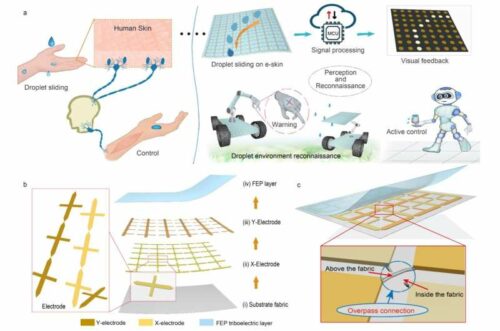Researchers from Donghua University & the National University of Singapore have developed an e-skin that detects liquid movement on surfaces and converts it into electrical signals.

Numerous research groups have recently focused on developing electronic artificial skins for humanoid robots, smart prosthetics, and bio-inspired systems. These skins would detect object textures and tactile qualities, helping systems make decisions based on the tactile information gathered.
A team from Donghua University and the National University of Singapore recently created an electronic skin (e-skin) capable of detecting surface liquid movement. The e-skin translates the motion of sliding droplets into electrical signals, which are fed to an indicator.
Humans naturally sense the movement of liquid droplets on their skin, a helpful skill for handling tasks in moist environments. To mimic this ability in their electronic skin, Bai and his team were inspired by a common sight: a soccer ball rolling across a floor tile.
The Dynamic Electronic Skin (DES) developed by the research team features a network of interwoven electrodes. These electrodes can detect different dynamic sliding behaviours of droplets and convert the friction generated into electrical signals.
The ability to perceive the sliding behaviour of droplets is primarily due to the clever design of a network of co-layered, interlaced electrodes. This network features two separate series of electrodes on the same layer, which do not conduct to each other. Additionally, the design maintains an equal induction distance between the droplet and each series of electrodes.
Once the e-skin transforms the sliding droplet movements into electrical signals, it transmits a visual representation of these movements to an indicator. Additionally, the skin is capable of tracking the direction of droplet flow and managing water leakage.
The e-skin described in this recent study may soon be implemented in robotic systems for further performance evaluations. Looking ahead, it has the potential to enhance humanoid robots by providing them with more sophisticated tactile sensing abilities, thereby narrowing the sensory perception gap between humans and robots.
Reference: Yunlong Xu et al, Bionic e-skin with precise multi-directional droplet sliding sensing for enhanced robotic perception, Nature Communications (2024). DOI: 10.1038/s41467-024-50270-8







